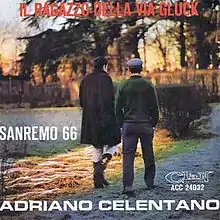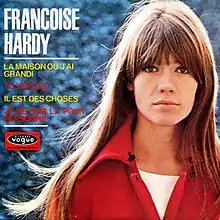Il ragazzo della via Gluck
"Il ragazzo della via Gluck" ("The boy from Gluck Street") is an Italian pop song by Adriano Celentano, covered by artists from many other countries.
| "Il ragazzo della via Gluck" | |
|---|---|
 | |
| Single by Adriano Celentano | |
| A-side | "Il ragazzo della via Gluck" |
| B-side | "Chi era lui" |
| Released | February 1966 |
| Genre | Pop |
| Label | Clan Celentano |
| Songwriter(s) | Miki Del Prete Adriano Celentano Luciano Beretta |
Composition
The music of the song is by Adriano Celentano and the lyrics by Luciano Beretta and Miki Del Prete. It was released in 1966 as a double A-side single by Celentano, with "Chi era lui" on the flipside, composed by Paolo Conte with lyrics by Mogol and Miki Del Prete. Both tracks were arranged by Detto Mariano. The tracks' duration was 4:17 for "Il ragazzo della via Gluck" and 2:49 for "Chi era lui".
History
The song originally appeared in March 1966 in Celentano's album La festa and in the follow-up Celentano album Il ragazzo della via Gluck, released in November 1966.
The song launched at the Sanremo Festival in 1966 where it competed with little success. It was eliminated from competition after the first night. But eventually it gained great favour with fans making it the best-known and most representative song of Celentano, with many autobiographical references; Via Gluck was the street of Milan where he lived as a boy with the family, and "eight years" ("...passano gli anni, ma 8 son lunghi...." meaning "...the years go by, but 8 they are long....") is a reference to the top of Celentano's recording career from 1958 to 1966.
Italian covers
In the same year of its original release, Giorgio Gaber recorded a cover version, that was published twice as an attachment to the Italian music magazine Pop. The first time, in March 1966, as a single containing "Il ragazzo della via Gluck"/"Dio, come ti amo" ("God, I love you so"), and the second, in June 1966, containing "Il ragazzo della via Gluck"/"Una casa in cima al mondo" ("A house on top of the world"). Giorgio Gaber also released a response to the song named "La risposta al ragazzo della Via Gluck" ("The response to the boy from Gluck Street").
In 2004, Adriano Celentano recorded the track with new lyrics and released it as "Quel Casinha" ("That Little House") in his album C'è sempre un motivo (There's always a reason). The new text was sung in Creole with Cesária Évora.
In February 2013, the Italian group Almamegretta, together with James Senese, Marcello Coleman and Clementino, performed the song on the fourth evening of the 2013 Sanremo Music Festival.[1]
International covers
"Tar and Cement"
In 1966, the American singer Verdelle Smith sang an English version titled "Tar and Cement", with songwriting credit to Paul Vance, Lee Pockriss, Luciano Beretta, Michele Del Prete, and Adriano Celentano. It was her only hit. "Tar and Cement" made it to #1 in Australia and to #38 in the U.S. It was also #6 on "Keener 13" from Detroit radio station WKNR for the week ending Monday June 27, 1966. Smith's "Tar and Cement" was included in the 2004 compilation CD, Girls Go Zonk: US Dream Babes.
The song "Tar and Cement" was also recorded by Caroline Munro. It was a big hit for Joe Dolan in Ireland.
"La maison où j'ai grandi"
It became a favourite song in France when covered by Eddy Marnay with French lyrics as "La maison où j'ai grandi". Marnay himself translated the lyrics from Italian to French.
"La maison où j'ai grandi" was also performed more famously by Françoise Hardy and it appears on her album known as La maison où j'ai grandi. The album was released without a title and is identified chiefly by the song it carries, its major hit. Hardy had admired Celentano's autobiographical song "Il ragazzo della via Gluck" having seen him perform it at the Sanremo in January 1966.
Looking back at the song in 2004, she said she felt an emotion of sadness at the time she heard the song for her mother, an assistant accountant, who had raised Françoise and her younger sister alone.[3]
"The Story of a Country Boy"
Belgian band The Cousins covered the song in English as "Story of a Country Boy" on the B-side of their 1966 single "You Will Find Another Baby". The song was the lead track on the 1966 French EP "The new sound of The Cousins", a compilation of both their 1966 singles. It was the final release by the original band, which parted ways a few months after its release.
"Lyckliga gatan"
The song enjoyed very similar popularity in Sweden, when the singer Anna-Lena Löfgren sang it with Swedish language lyrics as "Lyckliga gatan". It was released in 1967 and was certified gold in Sweden and platinum and diamond in Norway. It used the melody of the Italian song, with completely different lyrics that nonetheless convey the message and moral of the song.
"Immer am Sonntag"
Anna-Lena Löfgren built on her success in Sweden and Norway by recording a German-language version of the song, as "Immer am Sonntag" becoming very successful in Germany, releasing tens of other German language songs.
"Lykklige gate"
A Norwegian version released in 1968 on a single (Triola records) sung by Margrethe Toresen. The Swedish version is still vastly more popular in Norway.
"Der Junge aus der Via Gluck"
Another German-language version was recorded in March 1966 by the German television-star and radio-presenter (for Radio Luxemburg) Camillo Felgen.
"Závidím"
Czech version of this song, which lyrics was written by Jiří Grossmann, was performed by Naďa Urbánková.
"Het huis dat tussen rozen stond"
Belgian singer Sanne recorded in 1993 a version in Dutch, with lyrics by Erik Van Neygen and Marc Van Caelenberg.
"La casa donde yo crecí"
In 1999, the Argentinian girlband Seducidas y abandonadas covered the track in Spanish as "La casa donde yo crecí". It appears on their second album, Las 4 en punto.
'Η ιστορία ενός φίλου απ' τα παλιά'
In 2020, a Greek version of the original song was published on YouTube. This version was product of a private work by Vasilis Mouskouris. The Greek title of the song is 'Η ιστορία ενός φίλου από τα παλιά', which literary means 'The story of an old friend'. This version can be found on YouTube by typing or with copy/paste: 'Η ιστορία ενός φίλου απ' τα παλιά (Il ragazzo della via Gluck)'
References
- "Sanremo, the fourth evening". 12points.tv. February 15, 2013.
- Disques Vogue/Vogue international industries (EPL 8427)
- Interview, Paris Match, issue #2902, 2004
